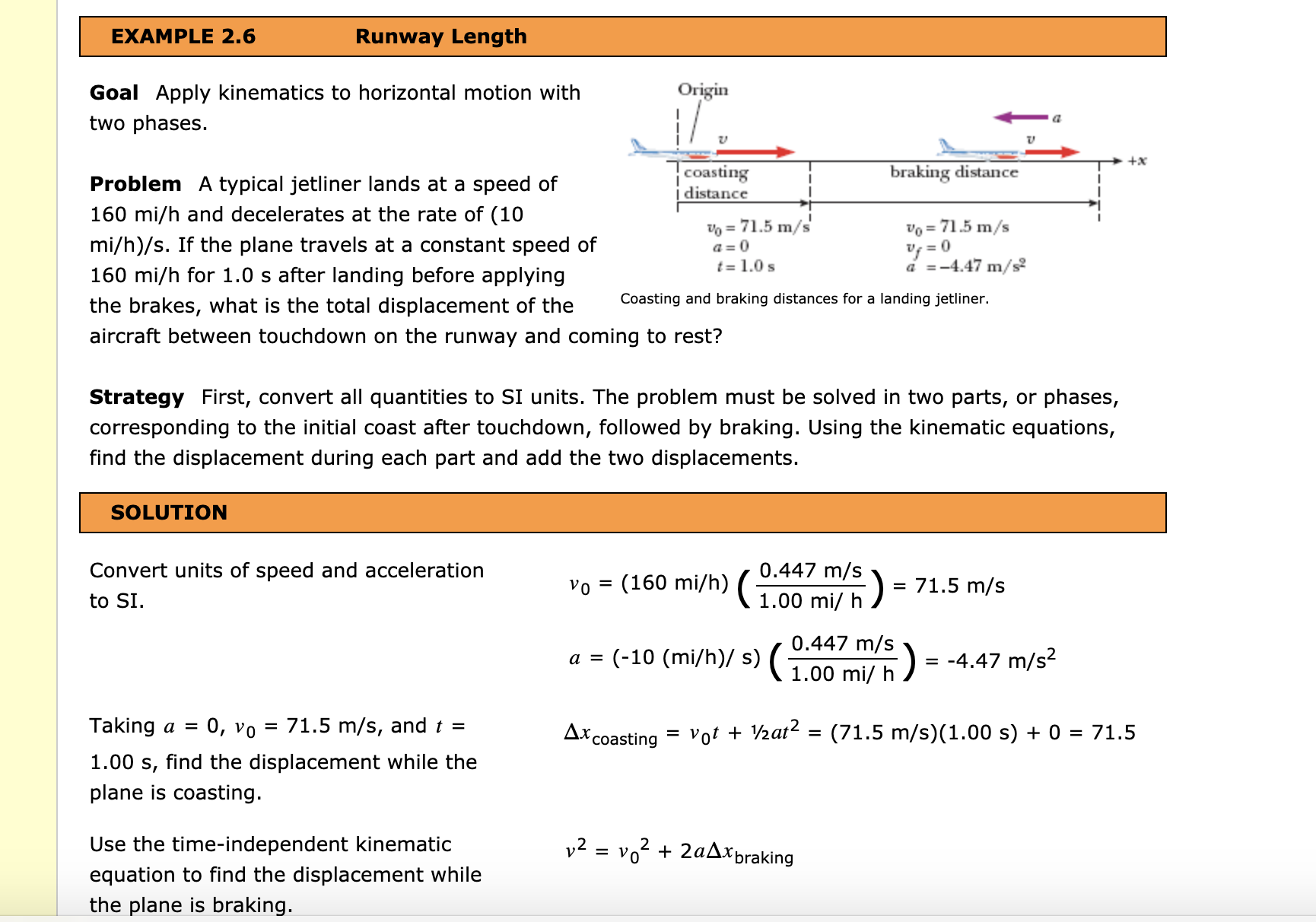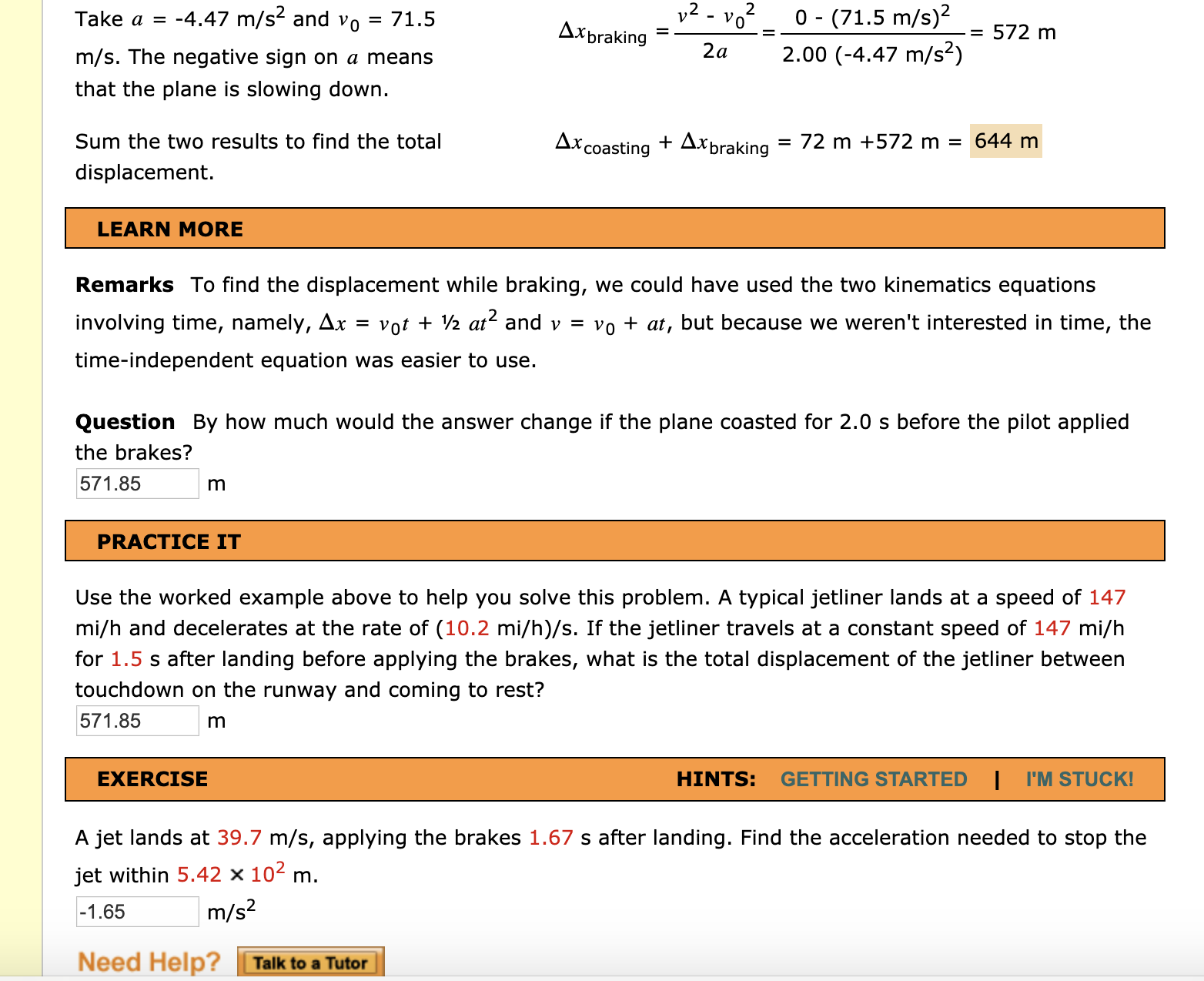EXAMPLE 2.6 Runway Length Origin Goal Apply kinematics to horizontal motion with two phases. +x coasting i distance braking distance Problem A typical jetliner lands at a speed of 160 mi/h and decelerates at the rate of (10 V% = 71.5 m/s a = 0 t = 1.0 s vo = 71.5 m/s mi/h)/s. If the plane travels at a constant speed of vy = 0 a =-4.47 m/s2 160 mi/h for 1.0 s after landing before applying Coasting and braking distances for a landing jetliner. the brakes, what is the total displacement of the aircraft between touchdown on the runway and coming to rest? Strategy First, convert all quantities to SI units. The problem must be solved in two parts, or phases, corresponding to the initial coast after touchdown, followed by braking. Using the kinematic equations, find the displacement during each part and add the two displacements. SOLUTION 0.447 m/s Convert units of speed and acceleration vo = (160 mi/h) = 71.5 m/s 1.00 mi/ h ) to SI. 0.447 m/s (-10 (mi/h)/ s)( 1.00 mi/ h ) = -4.47 m/s2 0, vo = 71.5 m/s, and t = Taking a = vot + V2at? = (71.5 m/s)(1.00 s) + 0 = 71.5 Ax coasting %3D 1.00 s, find the displacement while the plane is coasting. v2 = vo? + 2aAxbraking Use the time-independent kinematic %3D equation to find the displacement while the plane is braking. 0 - (71.5 m/s)? - vo Take a = -4.47 m/s and vo 71.5 Axbraking -= 572 m 2a 2.00 (-4.47 m/s²) m/s. The negative sign on a means that the plane is slowing down. 644 m = 72 m +572 m = Sum the two results to find the total Ax coasting + Axbraking displacement. LEARN MORE Remarks To find the displacement while braking, we could have used the two kinematics equations vot + V2 at? and v = vo + at, but because we weren't interested in time, the involving time, namely, Ax time-independent equation was easier to use. Question By how much would the answer change if the plane coasted for 2.0 s before the pilot applied the brakes? 571.85 PRACTICE IT Use the worked example above to help you solve this problem. A typical jetliner lands at a speed of 147 mi/h and decelerates at the rate of (10.2 mi/h)/s. If the jetliner travels at a constant speed of 147 mi/h for 1.5 s after landing before applying the brakes, what is the total displacement of the jetliner between touchdown on the runway and coming to rest? 571.85 EXERCISE HINTS: GETTING STARTED I I'M STUCK! A jet lands at 39.7 m/s, applying the brakes 1.67 s after landing. Find the acceleration needed to stop the jet within 5.42 × 102 m. m/s? -1.65 Need Help? Talk to a Tutor
EXAMPLE 2.6 Runway Length Origin Goal Apply kinematics to horizontal motion with two phases. +x coasting i distance braking distance Problem A typical jetliner lands at a speed of 160 mi/h and decelerates at the rate of (10 V% = 71.5 m/s a = 0 t = 1.0 s vo = 71.5 m/s mi/h)/s. If the plane travels at a constant speed of vy = 0 a =-4.47 m/s2 160 mi/h for 1.0 s after landing before applying Coasting and braking distances for a landing jetliner. the brakes, what is the total displacement of the aircraft between touchdown on the runway and coming to rest? Strategy First, convert all quantities to SI units. The problem must be solved in two parts, or phases, corresponding to the initial coast after touchdown, followed by braking. Using the kinematic equations, find the displacement during each part and add the two displacements. SOLUTION 0.447 m/s Convert units of speed and acceleration vo = (160 mi/h) = 71.5 m/s 1.00 mi/ h ) to SI. 0.447 m/s (-10 (mi/h)/ s)( 1.00 mi/ h ) = -4.47 m/s2 0, vo = 71.5 m/s, and t = Taking a = vot + V2at? = (71.5 m/s)(1.00 s) + 0 = 71.5 Ax coasting %3D 1.00 s, find the displacement while the plane is coasting. v2 = vo? + 2aAxbraking Use the time-independent kinematic %3D equation to find the displacement while the plane is braking. 0 - (71.5 m/s)? - vo Take a = -4.47 m/s and vo 71.5 Axbraking -= 572 m 2a 2.00 (-4.47 m/s²) m/s. The negative sign on a means that the plane is slowing down. 644 m = 72 m +572 m = Sum the two results to find the total Ax coasting + Axbraking displacement. LEARN MORE Remarks To find the displacement while braking, we could have used the two kinematics equations vot + V2 at? and v = vo + at, but because we weren't interested in time, the involving time, namely, Ax time-independent equation was easier to use. Question By how much would the answer change if the plane coasted for 2.0 s before the pilot applied the brakes? 571.85 PRACTICE IT Use the worked example above to help you solve this problem. A typical jetliner lands at a speed of 147 mi/h and decelerates at the rate of (10.2 mi/h)/s. If the jetliner travels at a constant speed of 147 mi/h for 1.5 s after landing before applying the brakes, what is the total displacement of the jetliner between touchdown on the runway and coming to rest? 571.85 EXERCISE HINTS: GETTING STARTED I I'M STUCK! A jet lands at 39.7 m/s, applying the brakes 1.67 s after landing. Find the acceleration needed to stop the jet within 5.42 × 102 m. m/s? -1.65 Need Help? Talk to a Tutor
University Physics Volume 1
18th Edition
ISBN:9781938168277
Author:William Moebs, Samuel J. Ling, Jeff Sanny
Publisher:William Moebs, Samuel J. Ling, Jeff Sanny
Chapter2: Vectors
Section: Chapter Questions
Problem 61P: In the control tower at a regional airport, an air traffic controller monitors two aircraft as their...
Related questions
Question
Hi, this has a few sub-questions but it's still all 1 question.
See the 2 pics & provide the correct answer ASAP.
List it clearly as a, b, & c.
Much Appreciated :D
Thanks! ??

Transcribed Image Text:EXAMPLE 2.6
Runway Length
Origin
Goal Apply kinematics to horizontal motion with
two phases.
+x
coasting
i distance
braking distance
Problem A typical jetliner lands at a speed of
160 mi/h and decelerates at the rate of (10
V% = 71.5 m/s
a = 0
t = 1.0 s
vo = 71.5 m/s
mi/h)/s. If the plane travels at a constant speed of
vy = 0
a =-4.47 m/s2
160 mi/h for 1.0 s after landing before applying
Coasting and braking distances for a landing jetliner.
the brakes, what is the total displacement of the
aircraft between touchdown on the runway and coming to rest?
Strategy First, convert all quantities to SI units. The problem must be solved in two parts, or phases,
corresponding to the initial coast after touchdown, followed by braking. Using the kinematic equations,
find the displacement during each part and add the two displacements.
SOLUTION
0.447 m/s
Convert units of speed and acceleration
vo = (160 mi/h)
= 71.5 m/s
1.00 mi/ h )
to SI.
0.447 m/s
(-10 (mi/h)/ s)( 1.00 mi/ h )
= -4.47 m/s2
0, vo
= 71.5 m/s, and t =
Taking a =
vot + V2at? = (71.5 m/s)(1.00 s) + 0 = 71.5
Ax coasting
%3D
1.00 s, find the displacement while the
plane is coasting.
v2 = vo? + 2aAxbraking
Use the time-independent kinematic
%3D
equation to find the displacement while
the plane is braking.

Transcribed Image Text:0 - (71.5 m/s)?
- vo
Take a = -4.47 m/s and vo
71.5
Axbraking
-= 572 m
2a
2.00 (-4.47 m/s²)
m/s. The negative sign on a means
that the plane is slowing down.
644 m
= 72 m +572 m =
Sum the two results to find the total
Ax coasting + Axbraking
displacement.
LEARN MORE
Remarks To find the displacement while braking, we could have used the two kinematics equations
vot + V2 at? and v = vo + at, but because we weren't interested in time, the
involving time, namely, Ax
time-independent equation was easier to use.
Question By how much would the answer change if the plane coasted for 2.0 s before the pilot applied
the brakes?
571.85
PRACTICE IT
Use the worked example above to help you solve this problem. A typical jetliner lands at a speed of 147
mi/h and decelerates at the rate of (10.2 mi/h)/s. If the jetliner travels at a constant speed of 147 mi/h
for 1.5 s after landing before applying the brakes, what is the total displacement of the jetliner between
touchdown on the runway and coming to rest?
571.85
EXERCISE
HINTS:
GETTING STARTED I
I'M STUCK!
A jet lands at 39.7 m/s, applying the brakes 1.67 s after landing. Find the acceleration needed to stop the
jet within 5.42 × 102 m.
m/s?
-1.65
Need Help?
Talk to a Tutor
Expert Solution
Trending now
This is a popular solution!
Step by step
Solved in 9 steps with 8 images

Knowledge Booster
Learn more about
Need a deep-dive on the concept behind this application? Look no further. Learn more about this topic, physics and related others by exploring similar questions and additional content below.Recommended textbooks for you

University Physics Volume 1
Physics
ISBN:
9781938168277
Author:
William Moebs, Samuel J. Ling, Jeff Sanny
Publisher:
OpenStax - Rice University

College Physics
Physics
ISBN:
9781305952300
Author:
Raymond A. Serway, Chris Vuille
Publisher:
Cengage Learning

College Physics
Physics
ISBN:
9781938168000
Author:
Paul Peter Urone, Roger Hinrichs
Publisher:
OpenStax College

University Physics Volume 1
Physics
ISBN:
9781938168277
Author:
William Moebs, Samuel J. Ling, Jeff Sanny
Publisher:
OpenStax - Rice University

College Physics
Physics
ISBN:
9781305952300
Author:
Raymond A. Serway, Chris Vuille
Publisher:
Cengage Learning

College Physics
Physics
ISBN:
9781938168000
Author:
Paul Peter Urone, Roger Hinrichs
Publisher:
OpenStax College

Physics for Scientists and Engineers, Technology …
Physics
ISBN:
9781305116399
Author:
Raymond A. Serway, John W. Jewett
Publisher:
Cengage Learning